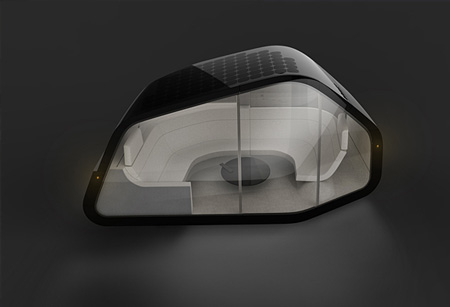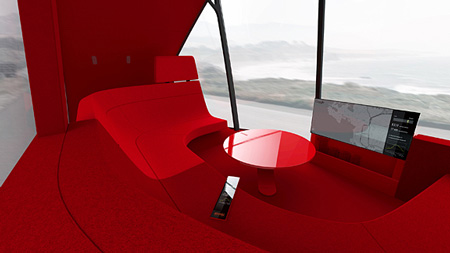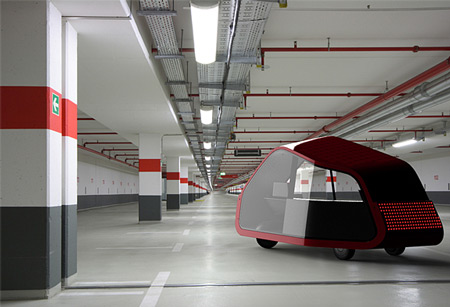
I’m one of those guys that doesn’t even like to drive automatic, so you’d think that the idea of a driverless car would send me running to the hills, shrieking like Heidi Montag in a Costa Rican jungle. Not necessarily true — industrial design team Mike + Maaike have come up with the Autonomobile (ATNMBL), a self-driving electric passenger vehicle that will change everything about commuting. Most driverless vehicle systems demand a complete infrastructure redesign, with electric fields in the roads or whatever. Not the ATNMBL — it claims to autonomously navigate itself through a synchronized system of GPS and sensors:
“Our vision is a new focus on quality of time while in traffic and transit. Dismissing the need for extreme MPH and acceleration as irrelevant, performance can be measured by time savings instead. Driverless cars, once a fantasy requiring new roads and infrastructure, are now technologically possible, even inevitable. GPS, sophisticated sensors, and navigation databases will allow driverless vehicles to operate on the same roads we have today…ATNMBL is our vision of a concept car for 2040 that represents the end of driving.
Upon entering ATNMBL, passengers are presented with the question: “Where can I take you?”. There is no steering wheel, brake pedal or drivers seat. ATNMBL drives by itself. …Electric motors in each wheel provide all-wheel drive. Electric power is stored underneath the seating and floor with additional power provided by solar panels on the roof. Within a gridded pattern on the front and rear is an array of headlights, tail lights and sensors.
Passengers enter ATNMBL from the curb side through an electric glass sliding door into a standing-height entryway. Inside, the seating arrangement is a direct reference to the familiar living-room setting of a couch, side chair and low table…Centrally oriented is a large flat display that features live trip information, maps, and entertainment. The display can slide up to reveal a bar behind. A new and comprehensive sense of control is introduced through voice recognition and a touch screen remote control (or one’s personal phone).
The list of life-enriching benefits is long: accessibility for young, old, and disabled (no drivers licenses), no searching for parking (it will drop you off and park itself), fewer cars will serve more people, less energy use, people will save hours each day (think autonomous check-ups and grocery pickups). Most importantly, there will be far fewer fatalities and there will always be a designated driver.
Ok, so you’re promising me 12-year Balvenie scotch on the rocks whilst I commute, a Mad Men marathon, and 24-hour designated driver for the rest of times — and I don’t have to look for parking??? I am giddy, and intrigued. Too bad it’s all fantasy — there’s no description of how exactly these sensors and GPS would work in concert to keep you from smashing into a fallen tree on the road. Besides, even if they do work it out, that won’t be till 2040 — I’ll be lucky to even need a designated driver by then. Still, always good to ponder the Great Potential Futureworld…


